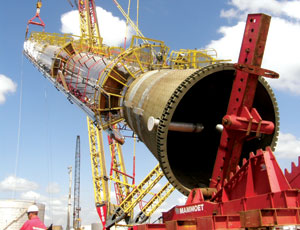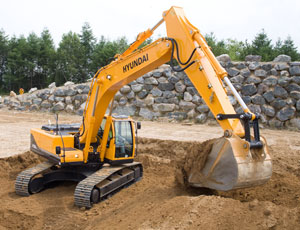When Caterpillar Inc.’s run of record sales and profits is over for the foreseeable future, you know the world’s economic condition is in bad shape. Contractors are hitting the auctions and used-equipment lots. For less-fortunate businesses, it’s liquidation time. Prices are plummeting, and producers are hunkering down.


Coast-to-coast, factory workers are feeling the chill just in time for the holidays. In North Dakota, Bobcat Co. is freezing production for six weeks at two plants until skid-steer sales thaw out again. In Kansas, CNH Global is sending workers home on an extended vacation at a plant in Wichita. In Peoria, Ill., Caterpillar reached the end of the third quarter riding high from record earnings but is now predicting next year to run “about flat” with full-year 2008 results, says Chairman and CEO Jim Owens.
The problem, of course, is that fewer people are lining up to buy big iron. “This is a 1981-style recession,” says Frank Manfredi, an equipment-market analyst in Mundelein, Ill. “The third-quarter results are probably as good as it’s going to get for awhile, because the fourth quarter has the appearance of falling off a cliff.” Sales for most categories of construction equipment have been slipping gradually since homebuilding went on the decline, and the market’s downward movement could finally engage the ground—at rock bottom—as early as next year, analysts indicate.
Earthmoving equipment, as usual, looks to be the early-cycle indicator, and those sales are turning out to be worse than expected. Last month, Milwaukee-based Association of Equipment Manufacturers lowered its 2008 forecast for sales of new earthmoving units to a sickly 15.8% decline; last year, it had predicted a drop of only 1.7%. Next year, it sees another 3.3% dip. “If you can make it through ’09, you’ll be OK,” says Manfredi, who predicts the equipment market will have dropped 60% to 70% overall since its mid-decade high. The only major categories for which AEM is forecasting a rise in sales are lifting and concrete equipment.
A continued boost in global demand is helping to soften the blow, but the economic hedge of so-called “emerging markets,” such as China, Russia and India, didn’t entirely live up to its recession-proof promise. “A lot of OEMs convinced themselves, and others, this was a new ball game,” explains Charlie Rentschler, an analyst who watches equipment stocks for Wall Street Access. “What has made this thing a classical cycle is really the shortage of credit. I think that is the disease.”
A few glints of optimism remain, but many are “what-ifs,” including President-elect Obama’s pending infrastructure package, which Oak Brook, Ill.-based Associated Equipment Distributors supports, saying it could potentially prompt billions of dollars in equipment spending. “The housing market has [stunk] for more than two years now,” says Christian Klein, AED’s vice president and government affairs chief in Washington, D.C. Infrastructure work would help boost sales, as every dollar in federal spending for sewer and highway work puts 12¢ and 6.4¢, respectively, in machinery dealers’ pockets, he says. “If there is an industry out there that is poised to benefit...it is construction,” says Klein.
The Obama plan is not a certainty, though, and it may take time to unfold. “I think it will be at best late ’09 before you start to see impact from that,” predicts Rentschler. “And he’s not even in office yet, so who knows what’s going to happen?” Another potential bright spot is in one typical late-cycle laggard: the heavy lifting, rigging and transportation sector, though it could very soon be on its way down. Over the next months, Dutch contractor Mammoet Global B.V. will deploy across the U.S. 50% of its super-crane fleet for major petroleum, chemical and power upgrades still in the works.
The firm says it is shipping four of the world’s largest cranes to North America, each with an average lifting capacity of 2,000 tonnes. One project includes the Fluor-managed expansion of BP’s $3.8-billion refinery in Whiting, Ind., near Chicago, designed to process Canadian heavy crude. “Next year will be a better year than this year,” with growth of 10% to 20%, says Jan Kleijn, president and COO of Rosharon, Texas-based Mammoet USA Inc. “We will have a considerable amount of work in 2010, but 2011 depends on future developments.”
The stateside super-crane fleet will include one 3,600-tonne Mammoet Sliding Gantry (MSG), two other custom-made, 1,600-tonne Platform Twin-ring Containerized Cranes (PTCs) and one 1,350-tonne Liebherr LR11350 crawler crane. If needed, its Netherlands-based parent company has plans to add more leverage, having purchased components to begin building a new PTC, though it is waiting to see how the market performs before pulling the trigger. “We have the flexibility to either build another PTC or use the components for an ever bigger crane,” notes Kleijn, hinting that it may exceed MSG’s capacity. Both types were previously built during the boom of the late 1990s. Backlogs today are booked up through the middle of 2010.
The industrial sector’s outlook isn’t exactly rosy, though. Oil producers are pulling the plug on major expansions as crude prices fall. Wisconsin-based Manitowoc’s backlog is starting to slow down due to lagging tower-crane demand and contract delays hit by price uncertainty. “The turbulence in the global financial system is affecting our markets and customers,” says President and CEO Glen Tellock. “However, Manitowoc is a much better, balanced company than it was just five years ago.”
Construction executives are banking that capital and labor-intensive nuclear projects will come online to help offset reductions in oil. “I think there is a lot of wishful thinking going on,” says Rentschler. He and others see demand for earthmovers starting a typical climb in 2010 or early 2011, around the time late-cycle crane work is slowing down.
In the midst of so much uncertainty, new battle lines are being drawn. Manufacturers plan to roll out fuel-efficient, hybrid machines as early as next year, while others are fixing their existing offering. On Dec. 11, Hyundai’s U.S. equipment division launched a new line of excavators, the 9 Series, in a bid to move up in the domestic marketplace. Ripping a strategy from the pages of its automotive playbook, Hyundai says now is the time to boost its image, using performance and warranty upgrades. “Our global strategy is to be a top-five global leader in the industry,” says Corey Rogers, sales training manager for the Elk Grove Village, Ill.-based supplier.
The new excavator line is Hyundai’s first shot fired in the battle to gain share. The series was redesigned to improve hydraulics, performance and reliability, with a new structural warranty—5 years or 10,000 hours, and the first service call is free up to 500 hours—to emphasize its point. Is also is adding a telematics-based fleet-management tool to help users track their assets in real time.
Rogers acknowledges that dealers pegged Hyundai as a low-end competitor, but says, “This market positions us more competitively.” Undaunted by the sagging economy, Hyundai has added two new district managers for the West Coast and the Midwest in the past year in a bid to expand sales and distribution. The company has no U.S. factories, so its prices are positively affected by a strong dollar, and “we’re lean, which allows us to be more flexible,” Rogers says.
Government looks to be a solid play, so Hyundai is refocusing its dealers on municipalities. Municipal sales are strong in Georgia, New Hampshire, North Carolina and West Virginia, among other places. Hyundai is targeting the Southwest, too, but dealers there are harder to find. Somewhat embarrassingly for a supplier based in northern Illinois, Hyundai says it also needs to hit the Chicago market. Get ready for a rocky ride next year: Competition has a way of heating up in the worst of times.


Post a comment to this article
Report Abusive Comment